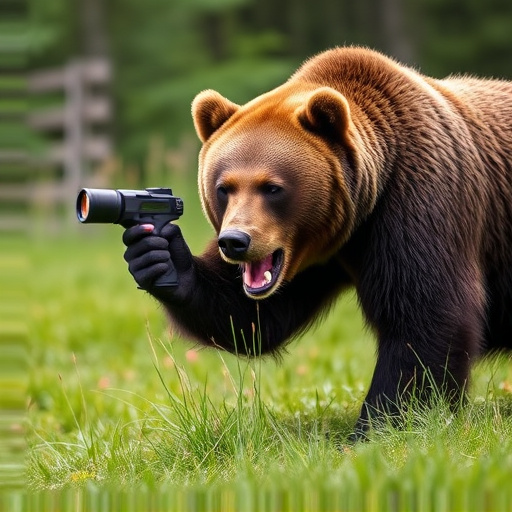TSA rules for bear spray ensure its safe transport while promoting aviation security. Canisters must be empty during airport checks, refilled afterward, and adhere to strict size, packaging, and labeling guidelines. Effective usage involves aiming high, maintaining distance, and spraying in quick bursts within a 20-30 foot range. Regular testing, proper storage, and understanding local regulations are best practices for enhancing safety during outdoor activities, especially when navigating predator-inhabited regions. Adhering to TSA rules is crucial for responsible carry and effectiveness against potential threats like bears, cougars, and coyotes.
“Discover the power of bear spray as a crucial defense mechanism in remote areas. This comprehensive guide explores how this lifesaving tool can deter predators, from bears to other wild animals. We delve into ‘Understanding Bear Spray: A Lifesaving Tool,’ ‘TSA Rules and Regulations for Transporting Bear Spray,’ and provide expert tips on its effective use and safety precautions. Learn the best practices for self-defense in nature, ensuring your peace of mind during outdoor adventures.”
- Understanding Bear Spray: A Lifesaving Tool in Remote Areas
- TSA Rules and Regulations for Transporting Bear Spray
- Effective Use of Bear Spray Against Predators: Techniques and Best Practices
- Safety Precautions and Considerations When Using Bear Spray
Understanding Bear Spray: A Lifesaving Tool in Remote Areas
Bear spray, also known as bear repellent, is a crucial tool for anyone venturing into remote areas where bears roam. It’s more than just a defense mechanism; it’s a lifesaver that offers a non-lethal way to deter aggressive encounters with these powerful animals. Bear spray works by creating an irritating aerosol that temporarily blinds and disorients the bear, allowing you time to escape to safety.
Understanding how to use bear spray effectively is paramount for anyone planning outdoor activities in bear country. The Transportation Security Administration (TSA) has specific rules regarding the carriage of bear spray, ensuring it remains accessible while promoting safety. These regulations dictate that bear spray canisters must be empty upon passage through security and filled after clearing checkpoints. By adhering to these guidelines, individuals can ensure they have this valuable defense mechanism at hand when needed most, making their outdoor adventures in bear-inhabited areas safer and more enjoyable.
TSA Rules and Regulations for Transporting Bear Spray
The Transportation Security Administration (TSA) has specific rules and regulations regarding the transportation of bear spray, a crucial defense mechanism against potential predators in wild areas. These guidelines ensure the safety of travelers and adhere to aviation security standards. According to TSA policies, bear spray is permitted in checked baggage only and must be packed appropriately. The container size limit is 355 milliliters (12 fluid ounces) per can, and it should be placed within a secure bag or packaging to prevent accidental discharge during flights.
Additionally, the TSA requires that all bear spray containers be in their original packaging with labels intact. It’s essential for travelers to familiarize themselves with these rules before packing bear spray for their trips, ensuring they comply with aviation security protocols and can carry this vital self-defense tool securely.
Effective Use of Bear Spray Against Predators: Techniques and Best Practices
When faced with predators, knowing how to effectively use bear spray can be a life-saving skill. It’s important to remember that bear spray is not just for bears; it can also deter other wild animals like cougars and coyotes. According to TSA Rules for Bear Spray, proper usage involves aiming high, keeping the nozzle focused on the target, and maintaining distance. Spraying in quick bursts rather than a prolonged stream is recommended to ensure maximum effectiveness. The goal is to create a barrier of capsaicin irritants that disrupt the animal’s senses, allowing you time to escape or seek shelter.
Best practices include ensuring your spray is always within reach, keeping it easily accessible for quick deployment, and regularly testing its functionality. It’s crucial to follow the manufacturer’s instructions regarding expiration dates and storage conditions. Additionally, familiarize yourself with local regulations regarding bear spray possession and use in the areas you frequent most. This proactive approach can significantly enhance your safety during outdoor activities in predator-inhabited regions.
Safety Precautions and Considerations When Using Bear Spray
Using bear spray can be an effective defense mechanism against potential predator encounters, but it’s crucial to approach this tool with caution and understanding. Before deploying bear spray, individuals should familiarize themselves with safety precautions outlined by regulatory bodies like the TSA (Transportation Security Administration). The TSA has specific rules for carrying bear spray, emphasizing responsible use and ensuring it doesn’t pose a risk to others or be misused in sensitive areas like airports.
Proper handling involves understanding the range and power of the spray, which typically ranges from 20-30 feet. Users must also learn the correct technique—aiming at the predator’s face while keeping bystanders out of the spray path. Moreover, regular maintenance and knowledge of expiration dates are vital to guarantee the product’s effectiveness when needed.
Bear spray can be a powerful defense against predators in remote areas, but it’s crucial to understand both its effective use and the TSA rules for transporting it. By adhering to best practices and safety precautions, you can ensure this lifesaving tool remains readily accessible when exploring nature. Remember, proper knowledge and responsible handling are key to harnessing the potential of bear spray while navigating remote landscapes. Stay informed, stay safe, and embrace the outdoors with confidence.
